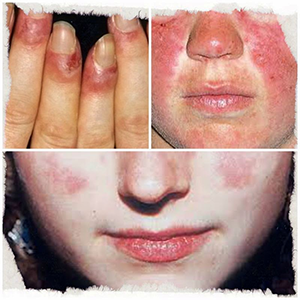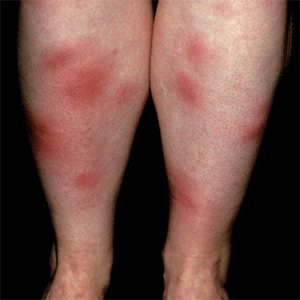Mold Illness, Mold Exposure, Mold Sickness Misdiagnosed | Diagnosis Mold Exposure
The Diagnosis of Mold Illness, Mold Sickness, or Mold Exposure can be Elusive.
More Times than not, it’s Misdiagnosed, and Recklessly Categorized as Other Diseases, Syndromes, or Even Mental Illness.

Chronic Fatigue Syndrome
Mold Exposure is commonly diagnosed as Chronic Fatigue Syndrome (CFS), which refers to severe, continued tiredness that is not relieved by rest and is not directly caused by other medical conditions. Approximately, 98% of all mold exposure victims are diagnosed with CFS. CFS occurs in mold exposure victims in two ways:
- It effects the HPA Axis (Hypothalamus, Pituitary and Adrenal glands) the exposure causes dysfunction of the adrenal glands and the neurotoxicity creates a vitamin D deficiency.
- The mold exposure victim experiences a wide range of gastrointestinal issues resulting in malabsorption resulting in CFS.
Mold exposure victims diagnosed with CFS require dual treatment for effective recovery.

Fibromyalgia
Many mold patients are mistakenly misdiagnosed with Fibromyalgia. Most mold exposure victims simply accept this diagnosis and just continue to live with the suffering until other symptoms that don’t make sense surface, and they begin to look for better answers and solutions.
Fibromyalgia is a common syndrome in which a person has long-term, body-wide pain and tenderness in the joints, muscles, tendons, and other soft tissues. Fibromyalgia has also been linked to fatigue, sleep problems, headaches, depression, and anxiety.

Asthma
Centers for Disease Control, “CDC”, reports 57% of all Asthma is environmentally induced, this includes mold exposure victims. Being diagnosed with Asthma and then it simply going away, or going dormant is a sign of misdiagnosis. Re-exposure to mold or other environmental impacts can cause a flare up of the condition. Asthma a defined is a permanent and irreversible condition of the lungs, a disorder that causes the airways of the lungs to swell and narrow, leading to wheezing, shortness of breath, chest tightness, and coughing.

Leaky Gut Syndrome
Leaky Gut Syndrome is a common condition that mold exposure victims are diagnosed with. This generally leads to a second diagnosis of Chronic Fatigue Syndrome. Leaky Gut is a name used to describe intestinal, or bowel hyper permeability, due to toxins and inflammation within the bowel. Few physicians understand the relationship of toxins in the bowel and how to properly eliminate the inflammation along with the toxicity.

Lyme Disease
Centers for Disease Control, “CDC”, reports only 28% of patients diagnosed with Lyme’s Disease, actually have Lyme’s. The large part of the misdiagnosis is the use of “Western Blot” test. The Western blot test may be read incorrectly by many physicians regarding the positive bands produced thus, rendering a false positive result. The symptoms of Lyme’s exactly mimic the symptoms of mold exposure; this is why mold exposure victims must be very careful of a Lyme’s misdiagnosis, as use of antibiotics in this scenario may cause conditions to worsen. Lyme’s disease is a bacterial infection that is spread through the bite of one of several types of ticks, the use, or misuse, of antibiotics can have long lasting negative effects on mold exposure victims.

Lupus
As with other inflammatory conditions Lupus is a common misdiagnosis for mold exposure victims. Systemic lupus erythematosus (SLE) is a disease that leads to long-term (chronic) inflammation. The cause of the inflammatory condition is not well understood and many times all three components required for a diagnosis of Lupus are not present. Sometimes patients may receive a Lupus diagnosis with only two of the diagnostic components present, commonly these are an elevated Antinuclear Antibody “ANA” and an elevated Titer. Many Lupus patients once treated for mold exposure, their symptoms of Lupus subside.

Sarcoidosis
As with many other inflammatory conditions, or sometimes referred to as a “Mystery Illnesses”, Sarcoidosis is another common misdiagnosis for mold exposure victims. Sarcoidosis is a disease in which inflammation occurs in the lymph nodes, lungs, liver, eyes, skin, or other tissues. These would be common symptoms of mycotoxin poisoning as most mold exposure victims are overwhelmed with inflammation due to Mycotoxicosis. Many Sarcoidosis patients once treated for mold exposure, their symptoms of inflammation subside.

COPD
Similar to an Asthma misdiagnosis, mold exposure victims may also fall in line for a misdiagnosis of COPD. Chronic obstructive pulmonary disease (COPD) is one of the most common lung diseases. It makes it difficult to breathe. There are two main forms of COPD: Chronic bronchitis, which involves a long-term cough with mucus; Emphysema, which involves destruction of the lungs over time. This can be the result of high levels of mold fine, or ultrafine particulate produced by the mold spore shells, or an inflammatory substance produced by the mold spore known as (1—–>3) β – D beta glucan. Massive amounts of these fine inflammatory particle are believed to have the ability to cause respiratory failure or respiratory collapse.

Multiple Sclerosis
Mold exposure victims must remember that the secondary metabolites, or organic poisons, produced by mold known as “Mycotoxins” are “Neurotoxins”, which means that these toxins can hurt the brain or nervous system. Multiple sclerosis is an autoimmune disease that affects the brain and spinal cord (central nervous system). If this condition is caused by mold exposure, it is imperative that the patient stop the damage in an effort that the nervous system can stop being damaged and can begin to start whatever healing process the body is capable of beginning.

Mental Illness
Mold exposure victims many times have been misdiagnosed with different forms of mental illness. Mold exposure victims must remember that the secondary metabolites, or organic poisons, produced by mold known as “Mycotoxins” are “Neurotoxins”, which means that these toxins can hurt the brain or nervous system. These toxins can also commonly alter memory, the thought process, and produce anxiety and depression. A mental disorder, or psychiatric disorder is a mental or behavioral pattern or anomaly that causes distress or disability, and which is not developmentally or socially normative. It is believed that many mold exposure victims suffering from mycotoxicosis, or mycotoxin poisoning, which mycotoxins are chemical poisons that can alter the neurotransmitters of the brain and cause brain chemical dysfunction. This type of dysfunction can alter behavior, create anger and many other behaviors wrongly associated with mental illness.

Rheumatoid Arthritis
Rheumatoid Arthritis “RA”, like many other inflammatory conditions can easily be misdiagnosed when it comes to mold exposure victims. RA is deemed as a long-term disease that leads to inflammation of the joints and surrounding tissues, it can also affect other organs. Many RA suffers when treated for mold exposure find that their symptoms and inflammation subside, in many cases RA may even become dormant after treatment for mold exposure.
Mold Exposure Can Cause Cancer

Mold Causes Cancer?
Aflatoxin, a mycotoxin, produced by a species of mold known as aspergillus, has been documented to have caused liver and kidney cancer in human beings.
Through specific DNA testing National Treatment Centers for Environmental Disease can demonstrate that certain proteins in the DNA strand can be affected by mycotoxins, forcing the reprogramming of certain proteins in the DNA strand to produce not only mutagenic cells, but also carcinogenic cells.
